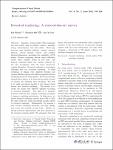Thông tin tài liệu
Thông tin siêu dữ liệu biểu ghi
| Trường DC | Giá trị | Ngôn ngữ |
|---|---|---|
| dc.contributor.author | Lili, Wang | - |
| dc.contributor.author | Xuehuai, Shi | - |
| dc.contributor.author | Yi, Liu | - |
| dc.date.accessioned | 2023-03-30T03:49:29Z | - |
| dc.date.available | 2023-03-30T03:49:29Z | - |
| dc.date.issued | 2023 | - |
| dc.identifier.uri | https://link.springer.com/article/10.1007/s41095-022-0306-4 | - |
| dc.identifier.uri | https://dlib.phenikaa-uni.edu.vn/handle/PNK/7324 | - |
| dc.description | CC BY | vi |
| dc.description.abstract | Recently, virtual reality (VR) technology has been widely used in medical, military, manufacturing, entertainment, and other fields. These applications must simulate different complex material surfaces, various dynamic objects, and complex physical phenomena, increasing the complexity of VR scenes. Current computing devices cannot efficiently render these complex scenes in real time, and delayed rendering makes the content observed by the user inconsistent with the user’s interaction, causing discomfort. Foveated rendering is a promising technique that can accelerate rendering. | vi |
| dc.language.iso | en | vi |
| dc.publisher | Springer | vi |
| dc.subject | VR | vi |
| dc.subject | VR scenes | vi |
| dc.title | Foveated rendering: A state-of-the-art survey | vi |
| dc.type | Book | vi |
| Bộ sưu tập | ||
| OER - Công nghệ thông tin | ||
Danh sách tệp tin đính kèm:

